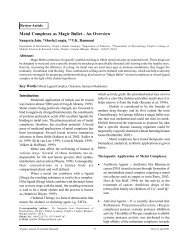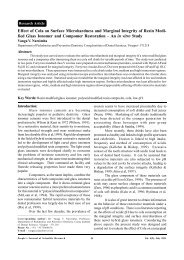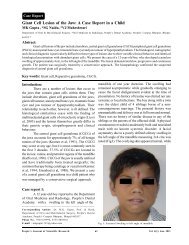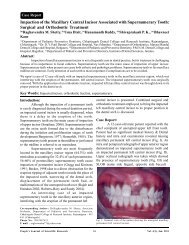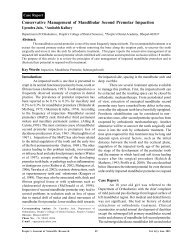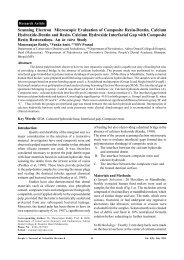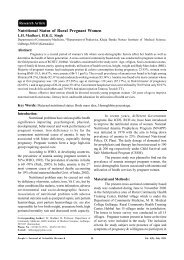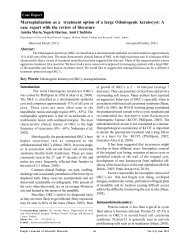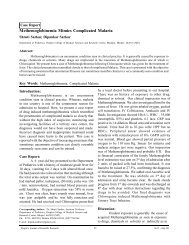Esthetic Closure of Diastema by Porcelain Laminate Veneers: A ...
Esthetic Closure of Diastema by Porcelain Laminate Veneers: A ...
Esthetic Closure of Diastema by Porcelain Laminate Veneers: A ...
You also want an ePaper? Increase the reach of your titles
YUMPU automatically turns print PDFs into web optimized ePapers that Google loves.
<strong>Esthetic</strong> <strong>Closure</strong> <strong>of</strong> <strong>Diastema</strong> <strong>by</strong> <strong>Porcelain</strong> <strong>Laminate</strong> <strong>Veneers</strong>: A Case Report -------------------------- A.G. BhoyarIt has become increasingly apparent thatconservation <strong>of</strong> tooth structure is a major factor indetermining the long term prognosis <strong>of</strong> any restorativeprocedure. One <strong>of</strong> the most important advantages <strong>of</strong>bonded porcelain veneers is that they are extremelyconservative in terms <strong>of</strong> tooth reduction. In the currentcase, only 0.5 mm reduction on the labial surface wasdone. This minimal reduction rarely, if ever, leads topulpal involvement which is a major advantage. Thehighly glazed surface <strong>of</strong> the porcelain laminates preventsplaque accumulation, considered important to attain ahealthy periodontal response. Excellent esthetics couldalso be achieved due to lifelike appearance <strong>of</strong> porcelainand scattering effect <strong>of</strong> the luting cement.However, porcelain laminates have their ownlimitations too. They should not be used when remainingenamel is inadequate to provide adequate retention.Large Class IV defects should probably not be restoredwith veneers because <strong>of</strong> the large amount <strong>of</strong>unsupported porcelain and the lack <strong>of</strong> tooth-coloredbacking. The amount <strong>of</strong> unsupported porcelain shouldbe carefully evaluated in cases with a large diastema .Darkly stained teeth are not optimally restored withveneers. The prognosis for veneers in bruxing isdoubtful. Certainly, such patients should be instructedto use a night guard after final restoration (Sheets &Taniguchi, 1990).Even, if the laminates fail in the long run, theconserved tooth can still be treated with a full crownrestoration. <strong>Porcelain</strong> laminate veneers <strong>of</strong>fer apredictable and successful treatment modality thatpreserves a maximum <strong>of</strong> sound tooth structure. Anincreased risk <strong>of</strong> failure is present only when veneersare partially bonded to dentin. The estimated survivalprobability <strong>of</strong> porcelain laminate veneers over a period<strong>of</strong> 10 years is 91% (Dumfahrt & Schäffer , 2000).Conclusion:Bonded porcelain veneers can providesuccessful esthetic and functional long-term servicefor patients. <strong>Porcelain</strong> laminate veneers <strong>of</strong>fers moreextensiveapplications when they are used cautiouslyand the results achieved have been gratifying for thecosmetic dentist and the patient alike. It has becomeincreasingly apparent that conservation <strong>of</strong> toothstructure is a major factor in determining the long-termprognosis <strong>of</strong> any restorative procedure.Bibliography:1. Bowen RL: Development <strong>of</strong> a silica-resin direct fillingmaterial. Report no. 6333. National Bureau <strong>of</strong> Standards,1958, Washington DC.2. Buonocore MG: A simple method <strong>of</strong> increasing theadhesion <strong>of</strong> acrylic filling materials to enamel surfaces.Journal <strong>of</strong> Dental Research,1955;34(6):849-853.3. Calamia JR: Clinical evaluation <strong>of</strong> etched porcelainveneers. American Journal <strong>of</strong> Dentistry,1989;2(1): 9-15.4. Cho GC, Donovan TE, Chee WW: Clinical experienceswith bonded porcelain laminate veneers. Journal <strong>of</strong>California Dental Association, 1998;26(2):121-127.5. Dlugokinski MD, Frazier KB, Goldstein RE: Restorativetreatment <strong>of</strong> <strong>Diastema</strong>. In: <strong>Esthetic</strong> in Dentistry (Vol.2).RE Goldstein, VB Hoywood (Eds.); 2 nd Edn.; BC DeckerInc. London, 2002;pp703-732.6. Dumfahrt H, Schäffer H: <strong>Porcelain</strong> laminate veneers. Aretrospective evaluation after 1 to 10 years <strong>of</strong> service:Part II-Clinical results. International Journal <strong>of</strong>Prosthodontics, 2000;13(1):9-18.7. Dunne SM, Millar BJ: A longitudinal study <strong>of</strong> the clinicalperformance <strong>of</strong> porcelain veneers. British DentalJournal,1993,175:317-321.8. Horn HR: <strong>Porcelain</strong> laminate veneers bonded to etchedenamel. Dental Clinics <strong>of</strong> North America, 1983;27(4):671-684.9. Jordan RE, Suzuki M, Senda A: Clinical evaluation <strong>of</strong>porcelain laminate veneers: a four-year recall report.Journal <strong>of</strong> <strong>Esthetic</strong> & Restorative Dentistry,1989;1(4):126-132.10. Karlsson S, Landahl I, Stegersjo G , Milleding P: A clinicalevaluation <strong>of</strong> ceramic laminate veneer. The InternationalJournal <strong>of</strong> Prosthodontics, 1992; 5(5):447-451.11. Oesterle LJ, Shellhart WE: Maxillary midline diastemas:a look at the causes. Journal <strong>of</strong> the American DentalAssociation, 1999;130(1):85-94.12. Peumans M, De-Munck J, Fieuws S, Lambrechts P,Vanherle G , Van Meerbeek B: A prospective ten-yearclinical trial <strong>of</strong> porcelain veneers. The Journal <strong>of</strong>Adhesive Dentistry, 2004;6(1):65-76.13. Pincus CR: Building mouth personality. Journal <strong>of</strong> SouthCalifornia Dental Association, 1938;14:125-129.14. Pippin DJ, Mixson JM, Soldan-Els AP: Clinical evaluation<strong>of</strong> restored maxillary incisors: veneers vs PFM crowns.Journal <strong>of</strong> the American Dental Association, 1995;126(11): 1523-1529.15. Rammelsberg P, Spiegl K, Eickemeyer G , Schimitter M:Clinical performance <strong>of</strong> metal free polymer crowns after3 years in service. Journal <strong>of</strong> Dentistry, 2005;33:517-523.16. Sheets CG, Taniguchi T: Advantages and limitations inthe use <strong>of</strong> porcelain veneer restorations. The Journal<strong>of</strong> Prosthetic Dentistry, 1990; 64(4):406-411.17. Strassler HE, Nathanson D: Clinical evaluation <strong>of</strong> etchedporcelain veneers over a period <strong>of</strong> 18 to 42 months.Journal <strong>of</strong> <strong>Esthetic</strong> Dentistry, 1989; 1(1):21-28.People’s Journal <strong>of</strong> Scientific Research 50Vol. 4(1), Jan. 2011




